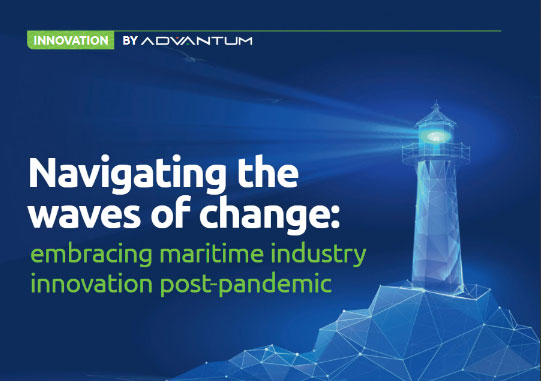Maritime Industry Innovation Post-Pandemic: Navigating the Waves of Change

As the maritime industry continues its journey toward a more resilient and innovative future, it’s essential to reflect on the profound digital transformation in the maritime industry that has taken place since the onset of the pandemic. The emergence of innovation and the adoption of advanced technologies have become the guiding forces in shaping our sector’s path forward. Today we explore how our industry has evolved, the technologies that have proven indispensable, and why returning to business as usual is no longer an option.
The pandemic’s onset thrust the global economy into uncharted waters, and the maritime industry was no exception. Lockdowns, supply chain disruptions, and the need for heightened safety measures created unprecedented challenges. However, adversity often serves as a catalyst for innovation. The maritime sector, known for its resilience, swiftly adapted to this new reality, recognizing that traditional practices could not withstand the winds of change.
Digital Technologies Transforming Maritime Operations Post-Pandemic
Innovation emerged as the silver lining of these turbulent times. The adoption of digital solutions, automation, and data-driven decision-making has revolutionized our operations. One of the crucial technologies that have taken center stage is Enterprise Management Systems such as the ADVANTUM logistics software used by Shipping Agents and Freight Forwarders. These systems facilitate both contactless and paperless processing. This optimizes documentation management and create comprehensive audit trails, ensuring accurate and tamper-proof records. They seamlessly integrate with third-party systems such as Port Community Systems and the Customs ASYCUDA platform and are accessible from anywhere in the world via the cloud, resulting in reduced fraud, expedited movement of goods, and minimized delays and costs.
Another technology that has proven indispensable is the Internet of Things (IoT). IoT sensors enable real-time monitoring of cargo conditions, vessel performance, and port operations. This data-driven approach ensures that goods are handled with the utmost care, reducing spoilage and losses. Moreover, IoT facilitates predictive maintenance, reducing downtime and costly repairs, providing greater efficiency and sustainability.
Artificial Intelligence (AI) is also quickly emerging as a driving force of innovation in our industry. AI-driven predictive analytics help us anticipate disruptions in supply chains, allowing us to make informed decisions to mitigate risks. Automated chatbots streamline customer service, ensuring quick responses and improved customer satisfaction. Machine learning algorithms enhance route optimization, reducing fuel consumption and emissions, thus contributing to our environmental responsibilities.
However, innovation doesn’t stop at technology; it also encompasses processes and workflows. The pandemic has forced us to reevaluate our approaches to workforce management. Remote monitoring and remote work arrangements have become essential components of our business continuity plans. This flexibility not only ensures the safety of our employees but also opens opportunities for talent acquisition and retention across borders.
Guiding Principles for Maritime Supply Chain Resilience
As we embrace these innovations, we must resist the temptation to revert to the pre-pandemic status quo. The lessons learned during these trying times have highlighted the need for resilience, agility, and adaptability. To ensure our industry’s continued success, we must commit to certain principles.
Firstly, we should prioritize sustainability. The maritime industry has a vital role to play in reducing its carbon footprint. Investing in cleaner propulsion technologies, such as LNG or hydrogen, and exploring renewable energy sources for port operations can significantly contribute to a greener future.
Secondly, cybersecurity must remain at the forefront. As our reliance on digital technologies grows, so does the risk of cyberattacks. Robust cybersecurity measures are paramount to protect sensitive data and maintain the integrity of our operations.
Thirdly, collaboration is key. The maritime industry is a complex ecosystem involving various stakeholders, from shippers and carriers to port authorities and customs. Building on the collaborative spirit that emerged during the pandemic, we must continue to work together to streamline processes, reduce friction, and enhance transparency.
The pandemic has been a catalyst for innovation in the maritime industry. The technologies and practices we have embraced have helped us navigate the challenges of the past. They have also positioned us for a more prosperous and sustainable future. As our industry continues its transformative journey, let us remember that returning to business as usual is no longer an option. Embracing innovation, sustainability, cybersecurity, and collaboration will be the guiding stars that lead us toward a brighter and more resilient future.
Visit www.advantumpcs.com to learn more about our innovative software solutions and network consultation services.
Originally published in the Caribbean Maritime Magazine Issue 50
